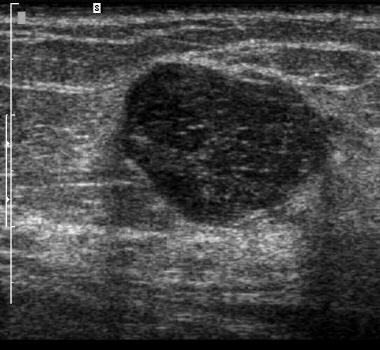
Ultrasound-guided surgery appears to be better able to completely excise breast tumors and spare healthy tissue than standard palpation-guided surgery.
A new study, presented at the 8th European Breast Cancer Conference (EBCC-8), held in Vienna, Austria, found that ultrasound-guided surgery can prevent the unacceptably high rate of tumor-involved resection margins seen in palpable breast cancer excision, and can reduce the amount of healthy breast tissue removed to optimal volume resection.
The technique is noninvasive, simple, safe, and effective.
Ultrasound-guided surgery is better at tissue sparing, "which will probably result in better cosmetic outcomes.
Currently, excision volumes are much larger when breast-conserving surgery is performed using guidance from the surgeon's palpation only. "Ideally, the tumor is removed with a margin of about 1 cm of healthy tissue."
However, excisions volumes in real life are about 2.5 times that.
The cosmetic results of breast-conserving surgery are thus often disappointing, with about 1 in 3 patients experiencing a poor result.
There is a high rate of tumor-involved margins, and about 20% of the time the tumor is not completely excised and additional treatment is necessary. These patients might need to undergo radiotherapy, additional surgery, or even a mastectomy.
Better Margins, Lower Volume Despite studies showing the benefits of ultrasound-guided surgery over wire localization for nonpalpable breast cancer, ultrasound has not been widely integrated into daily surgical practice.
Conversely, there has been little research into the use of ultrasound for palpable breast cancer. Dr. Krekel and colleagues conducted their randomized controlled trial to compare ultrasound-guided surgery with the standard palpation-guided surgery for palpable breast cancer.
The primary outcomes were margin status and the extent of healthy breast tissue resection. The cohort involved 124 patients with palpable T1 to T2 invasive breast cancer who were randomly assigned to either ultrasound-guided surgery (n = 61) or standard surgery (n = 63). The researchers analyzed specimen margins for tumor invasion and a calculated resection ratio to indicate the excess of healthy tissue resection. There were 53 women (84.1%) with negative margins in the group that received standard surgery, and 59 (96.7%) with negative margins in the group that received ultrasound-guided surgery (P < .05). For positive margins, the rate was 10 women (15.9%) with standard surgery and 2 (3.3%) with ultrasound-guided surgery (P < .05). In the ultrasound group, only 3.3% of margins were involved with invasive carcinoma, compared with 16.4% in the standard group (P < .05). "There was a big difference, and the amount of additional treatment was also much lower in the ultrasound group," said Dr. Krekel.
The resection ratio in the ultrasound group was optimal. "In the [standard] group, the volume of excision was twice as large as it should be," she noted. The excision volume in the standard group was 58 cc and in the ultrasound group was 40 cc, and the calculated resection ratio was 1.9 in the standard group and 1.0 in the ultrasound group (P < .05 for both). Tumors that were larger than 2.0 cm were associated with a lower calculated resection ratio (P < .0001) but a higher positive margin rate (P = .064).